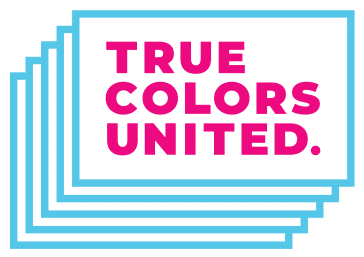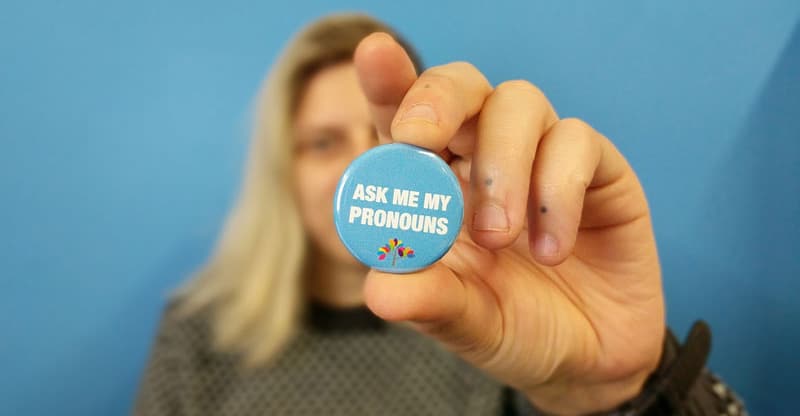What are gender pronouns?
Simply put, gender pronouns are the words we use to refer to people. You’re probably very familiar with the pronouns “he” and “she.” These terms fit some people, but not everyone identifies with them. Some people use “they” as their gender pronoun, and others use newer words like “ze” and “hir.” Many people (young folks, especially) are also creating their own words as they explore their identities. Just like with acronyms, gender pronouns often change and evolve over time.
By being mindful of pronouns in our everyday life, we are creating a culture of inclusion for lesbian, gay, bisexual, transgender, queer, and questioning (LGBTQ) youth and adults alike. Wearing a pronoun button, like the ones featured in our True Inclusion Toolbox, is an easy way to make your school, work, or community a safer place for LGBTQ folks. You can order our buttons here, or (if you’re the crafty type) download our graphics to make your own!
Why do gender pronouns matter?
We use gender pronouns every single day with just about everyone we meet. Referring to someone by their correct pronoun is a simple way to say, “I see you for who you are and respect you for it.” This is especially true for transgender folks and people outside of the gender binary.
It goes beyond “feeling” safe, too. For example, if a young person is repeatedly misgendered (referred to as the wrong gender) by their doctor or teacher, it sends the message that their needs don’t matter. When young people are welcomed and accepted for who they are, they’re more likely to succeed.
How do I ask someone their gender pronouns?
You can’t always tell what someone’s pronouns are just by looking at them. The easiest way to find out is to ask! We recommend getting into the habit of telling other people your pronouns when you first meet. It’s a great way to break the ice and show others that they can feel safe being their true selves around you.
Talking to people about their pronouns might feel strange at first, but don’t give up! By being mindful of others’ pronouns, you’re making a more inclusive culture for LGBTQ youth.
P.S. You can now get your own diversity posters, totes, mugs, stickers, and more! Proceeds support our work to end LGBTQ youth homelessness.
Rather read the video transcript? We’ve got you covered:
The first time you ask someone what pronouns they use, it may feel awkward. You may even be worried that you’ll offend the person. But assuming someone’s gender and getting it wrong could actually be more offensive. This is called “misgendering.”
If you happen to misgender someone, acknowledge your mistake, but be aware that over-apologizing can just make things more uncomfortable. Just say you’re sorry and move on. As with anything else, practice makes perfect, so let’s walk through some examples to make it less intimidating.
Here we are at the local library – (“SHH!” oh, sorry) – here we are at the local library with Brian and Star.
Brian greets Star at the book club meeting.
“Hi, my name is Brian. I use the pronouns he and him. How about you?”
“Oh, hey Brian. My name is Star. I use she and her.”
What’s great about this scenario is that Brian shares his own pronouns before he asks for Star’s. This breaks the ice and makes the exchange conversational rather than one-sided.
Sometimes you might be mid-conversation and realize that you never asked for the person’s pronouns. It’s not too late.
If that were to happen, Brian might say:
“Star, I just realized I never asked what pronouns you use.”
Asking about pronouns is becoming more common, but not everyone is used to doing it. Putting pronouns into practice sometimes involves managing reactions.
If Star responds with, “Why are you asking me this? Isn’t it clear?”
Brian might say: “I ask everyone this question because I want to be respectful and not make any assumptions.”
If Star is like, “Pronouns? What do you mean?”
Brian might respond: “I mean, do you use the pronouns ‘he/ him’, ‘she/her’. ‘they/them’ or something else?”
Keep in mind, singling people out can make them feel uncomfortable, so if you’re in a group setting, you’ll want to ask everyone what pronouns they use – not just the people you’re unsure about. And be sure to share your pronouns as well.
Whether you realize it or not, by doing this on a regular basis, you’re changing the culture around you.

